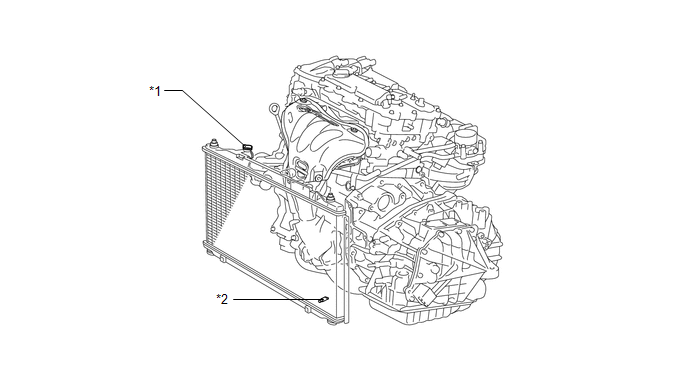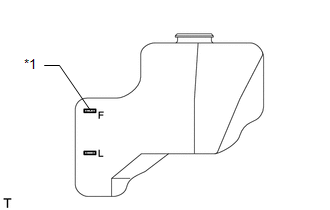Toyota Venza: Coolant
Replacement
REPLACEMENT
PROCEDURE
1. REMOVE NO. 1 ENGINE UNDER COVER
2. REMOVE NO. 2 ENGINE UNDER COVER
3. DRAIN ENGINE COOLANT
(a) Loosen the radiator drain cock plug and drain the coolant.
NOTICE:
Do not remove the reserve tank cap or radiator drain cock plug while the engine and radiator are still hot. Pressurized, hot engine coolant and steam may be released and cause serious burns.
HINT:
Collect the coolant in a container and dispose of it according to the regulations in your area.
(b) Remove the radiator cap sub-assembly from the radiator assembly.
 Text in Illustration
Text in Illustration
|
*1 |
Radiator Cap Sub-assembly |
*2 |
Radiator Drain Cock Plug |
4. ADD ENGINE COOLANT
(a) Tighten the radiator drain cock plug by hand.
(b) Slowly fill the radiator with TOYOTA Super Long Life Coolant (SLLC).
Standard Capacity:
7.1 liters (7.5 US qts, 6.2 lmp. qts)
HINT:
TOYOTA vehicles are filled with TOYOTA SLLC at the factory. In order to avoid damage to the engine cooling system and other technical problems, only use TOYOTA SLLC or similar high quality ethylene glycol based non-silicate, non-amine, non-nitrite, non-borate coolant with long-life hybrid organic acid technology (coolant with long-life hybrid organic acid technology is a combination of low phosphates and organic acids).
NOTICE:
Never use water as a substitute for engine coolant.
|
(c) Slowly pour coolant into the radiator reservoir tank until it reaches the full line. Text in Illustration
|
|
(d) Squeeze the No. 1 and No. 2 radiator hoses several times by hand, and then check the level of the coolant.
If the coolant level is low, add coolant.
(e) Bleed air from the cooling system.
(1) Warm up the engine until the thermostat opens. While the thermostat is open, circulate the coolant for several minutes.
HINT:
The thermostat open timing can be confirmed by squeezing the No. 2 radiator hose by hand, and sensing vibrations when the engine coolant starts to flow inside the hose.
(2) Maintain the engine speed at 2500 to 3000 rpm.
(3) Squeeze the inlet and No. 1 and No. 2 radiator hoses several times by hand to bleed air.
CAUTION:
When squeezing the radiator hoses:
- Wear protective gloves.
- Be careful as the radiator hoses are hot.
- Keep your hands away from the cooling fans.
NOTICE:
- Make sure that the radiator reservoir still has some coolant in it.
- If the coolant temperature gauge indicates an excessive temperature, turn off the engine and let it cool.
- If there is not enough coolant, the engine may overheat or be seriously damaged.
- If the radiator reservoir does not have enough coolant, perform the following: 1) stop the engine, 2) wait until the coolant has cooled down, and 3) add coolant until the reservoir is filled to the full line.
(f) Stop the engine and wait until the engine coolant cools down.
(g) Add engine coolant to the full line on the radiator reservoir.
5. INSPECT FOR COOLANT LEAK
.gif)
6. INSTALL NO. 2 ENGINE UNDER COVER
7. INSTALL NO. 1 ENGINE UNDER COVER
 1ar-fe Cooling
1ar-fe Cooling
...
Other materials about Toyota Venza:
HD Radio Tuner Malfunction (B1551,B158D,B15A0,B15B0,B15B3,B15B4,B15B7)
DESCRIPTION
These DTCs are stored when a malfunction occurs in the radio and display receiver
assembly.
DTC No.
DTC Detection Condition
Trouble Area
B1551
When any of the following conditions is ...
Chassis
General Maintenance
GENERAL MAINTENANCE
PROCEDURE
1. INSPECT STEERING LINKAGE AND GEAR HOUSING
(a) Check the steering wheel free play (See page
).
(b) Check the steering linkage for looseness or damage.
(1) Check that the tie rod ends do not have any ...
How To Proceed With Troubleshooting
CAUTION / NOTICE / HINT
HINT:
Use the following procedure to troubleshoot the engine immobiliser system.
*: Using the Techstream.
PROCEDURE
1.
VEHICLE BROUGHT TO WORKSHOP
NEXT
...
0.1285


